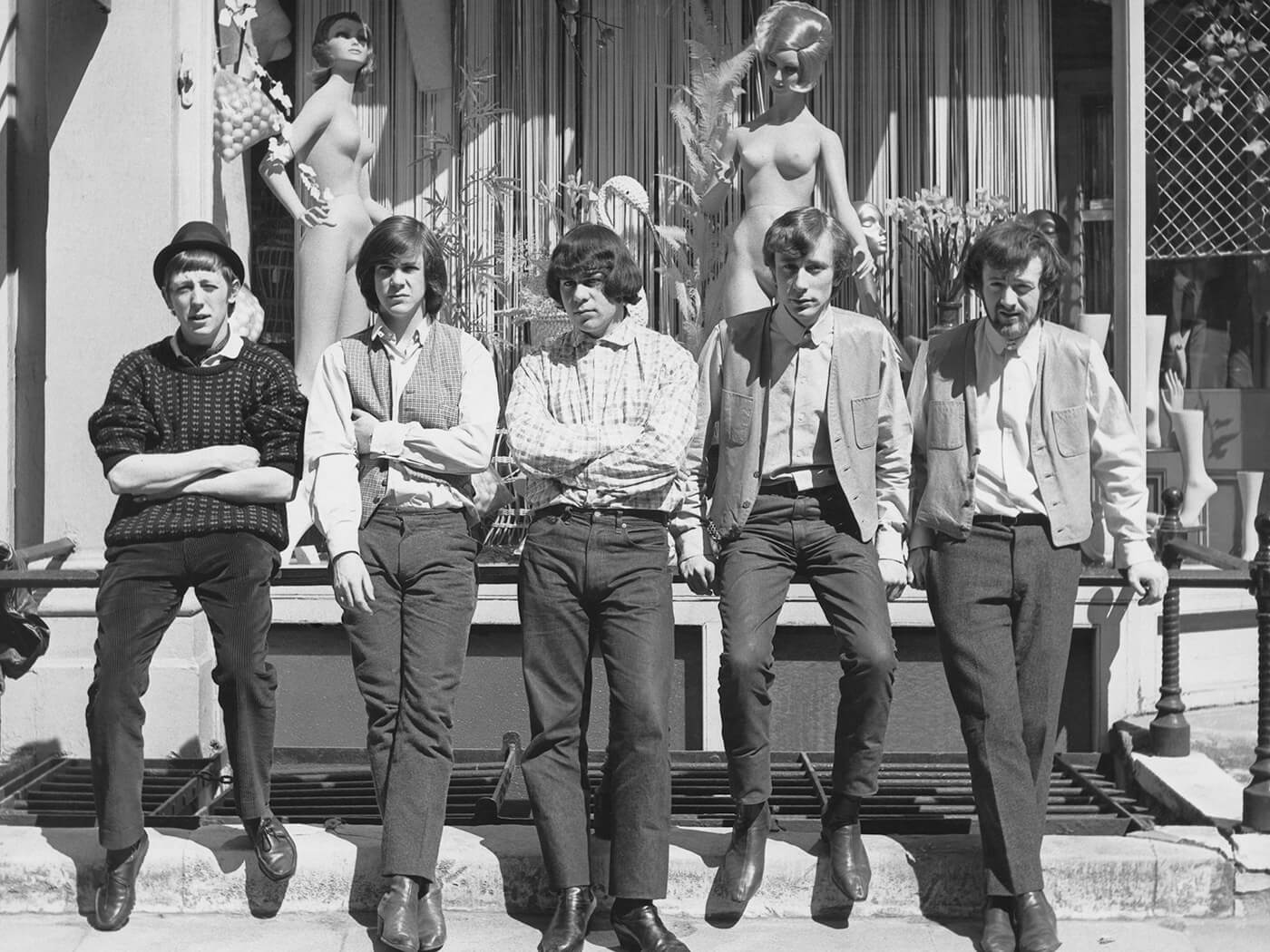The Pretty Things are the character actors of British rock – a Brian Glover or Richard E Grant to the Michael Caine or Roger Moore of the Stones/Beatles/Who. While the Pretties occasionally got the chance to play the leading man, their usual role has been as craggy-faced secondary players, present at many of the key moments in British music – friends of the Stones, covered by Bowie, signed to Led Zeppelin’s own label, shared a manager with Pink Floyd – and always delivering noteworthy moments when it was their cue before returning to the shadow of the big shots.
Madfish’s limited-edition box of the 13 studio albums recorded by The Pretty Things between 1965 and 2020 offers a chance to look at the band on their own terms rather than as bit parts in the cultural evolution of British rock. The focus on studio albums means the story isn’t quite complete – there’s no live shows or BBC sessions, none of their soundtrack work as Electric Banana, no non-album singles such as the landmark “Defecting Grey”, nor the private-press LP they did with French playboy Philippe DeBarge – but it provides a skeleton on which to focus study of a fascinating career.
Most music fans will know about Dick Taylor and Phil May’s shaggy-haired fuzzy garage rock origins and SF Sorrow, their pioneering, musically sophisticated psychedelic rock opera from 1968, but fewer will have explored their consistently adventurous output in the decade that followed, their astonishing 1980s foray into New Wave or the strong sequence of late albums delivered from a more mature perspective. Their career concluded with 2020’s Bare As Bone, Bright As Blood, recorded while singer May – the only man to appear on every album – was dying from lung disease. This sparse, haunting collection of acoustic ballads resulted in a musical epitaph to match Warren Zevon and Johnny Cash. In cinematic terms, it’s a final curtain that rivals any of Alan Rickman’s.
The long journey from The Pretty Things to Bare As Bone… says much about the maturation of British music over the course of The Pretty Things’ lifespan. Above all, it’s a story of the blues, which first ignited the creative fire within. On their debut record, The Pretty Things played blues as if they wanted to twist it into new shapes to the point of destruction; when they came back to it in 2020, they were ready to make a reckoning with the form – but that fire continued to burn.
The band began in the Kent R&B scene of the early 1960s, where Dick Taylor played in an early version of The Rolling Stones. They were named after a song written by Willie Dixon and performed by Muddy Waters, which they covered on debut LP The Pretty Things. As was customary, that album came out in UK and US versions. The one included here is the UK edition, which means there’s no room for “Rosalyn” (a single that saw Phil May’s hair featured on the cover of The Sunday Times Magazine) and “Don’t Bring Me Down”, both of which early fan Bowie covered on Pin Ups. The set instead starts with their very first UK album track, the savage “Road Runner”, a Bo Diddley cover and prime example of the unrestrained energy that made early Pretty Things so exciting. It’s dissolute and dirty R&B, with May’s throaty leer and Taylor’s alarming pyrotechnics introducing a band that promised to be even filthier than the Stones.
The impact and image of The Pretty Things was so powerful, it meant the music world was not ready for how fast the band would evolve. The soul-influenced What’s The Picture? showed they were eager to grow, while 1967’s under-rated Emotions was evidence they were better at marrying hard blues with psychedelia than almost any of their peers other than The Who. This reached its peak with SF Sorrow – a psychedelic rock opera exploring the life of a single character. It was brilliant and revolutionary – the first of its kind – but went almost completely ignored at the time.
At this point the story usually ends, but The Pretty Things had plenty of great music still to record. They flirted with the Ladbroke Grove scene before Dick Taylor dropped out for 1970’s Parachute, leaving May with writing partners Wally Waller (bass) and Jon Povey (keyboards). Parachute saw the band incorporate the influence of The Band on a mournful, moody album that captured an end-of-the-era hippie-wigs-in-Woolworths vibe. The Pretty Things’ familiarity with both garage rock and psychedelia made them adept at embracing the latest shift in musical styles, a smoothly ear-friendly take on innovation that would eventually become yacht rock. In another world, The Pretty Things could have been huge in the 1970s, but for whatever reason – be it fate or fashion or their refusal to sit still – it never quite clicked.
Waller was next to leave, with new arrival Pete Tolson replacing him as May’s co-writer
on the Freeway Madness LP. Tolson had an ear for a melody and Freeway Madness had potential singles – the galloping “Havana Bound” and hard rock swagger of “Religion’s Dead” – while the influence of The Band continued to linger in moments such as “Country Road”. For successor Silk Torpedo, the band were now signed to Swan Song, but even with the weight of the Zep machine behind them, they struggled to make an impact. It’s another good album, with The Pretty Things willing to have a crack at almost anything, from retro boogie (“Come Home Momma”) to bossa nova (“L.A.N.T.A”). Best of the lot is “Belfast Cowboy”, a melancholic study of the Troubles. Even the weakest third album in the mid-’70s trilogy, Savage Eye, has reggae (“I’m Keeping”) and gospel (“It’s Been So Long”) alongside superior heavy rock, balladry and the multi-part “Drowned Man”.
The Pretty Things split, before returning in 1980. Dick Taylor re-joined for Cross Talk, an extremely effective take on New Wave and probably the single most unexpected moment in their canon. May has the gulping vocals of Bob Geldof or David Byrne down pat, while Pete Tolson embraces the urgent scratchy guitar lines of a James Honeyman-Scott. They even dared write a song called “No Future” while imitating The Police, showing they still had the sense of humour that produced early B-side “£.S.d” – or as it was better known, “LSD”.
…Rage Before Beauty introduced their final phase. The comeback was recorded with the classic lineup of May, Taylor, Povey, Waller and drummer Skip Alan joined by guitarist Frank Holland, with guest spots from Dave Gilmour and Ronnie Spector. The band began to examine their own history on tracks like “Vivian Prince”, named after their first drummer, a theme continued nearly a decade later on 2007’s Balboa Island with career-scanning opener “The Beat Goes On”. The Sweet Pretty Things (Are In Bed Now, Of Course…) had a new lineup and their heaviest vibes on “The Same Sun”, “Dark Days”, “Dirty Song” and “Hell, Here And Nowhere”, dense, multi-layered beautiful heavy blues full of experience. And then came Bare As Bone…, basically just Taylor and May, working together for what they both knew would be the last time, re-examining the blues that brought them together in the first place. It’s moving and powerful, a celebration of music and friendship that elevates a fantastic career into something more profound. If there’s a thread that runs through the band’s career, it’s a love of adventure and on Bare As Bone…, May faced the final one with a boldness that inspires.

